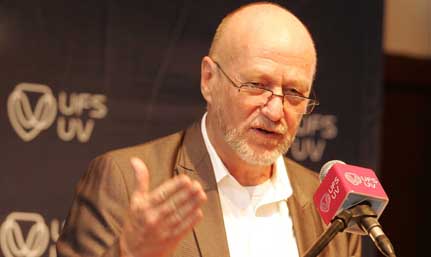 |
|
Mr Derek Hanekom, Minister of Science and Technology
Foto: Johan Roux
05 Desember 2012
|
People often fight about their differences, like skin colour, religion and more. “These differences are minute. We must celebrate our common ancestry and commit ourselves to a common destiny. Your work can make a difference.” This is according to Mr Derek Hanekom, Minister of Science and Technology.
He opened the Southern African Young Scientists Summer Programme (SA-YSSP) at the Bloemfontein Campus on Sunday 2 December 2012. The UFS is the first institution outside Austria to host the Summer Programme. A total of 19 young researchers from 17 countries will be hosted by the UFS until 28 February 2013. Researchers in the programme are, among others, from South Africa, Egypt, China, Italy, Sweden, Iran, Hungary, India, the USA and Indonesia.
The programme will form part of an annual three-month education, academic training and research capacity-building programme jointly organised by the International Institute for Applied Systems Analysis (IIASA), based in Austria, the National Research Foundation (NRF) and the Department of Science and Technology (DST). IIASA is an international research organisation that conducts policy-oriented scientific research in the three global problem areas of energy and climate change, food and water and poverty and equity. South Africa’s engagements with IIASA, specifically with regard to the SA-YSSP, relate primarily to the DST’s Ten-Year Innovation Plan.
Mr Hanekom spoke about the impact the growing global population, which is expected to grow from 7 billion in 2012 to 9 billion in 2050, has on natural resources. “We use purified water to flush our toilets while other people do not have clean drinking water. We cannot carry on like this. Somewhere it must stop, if we do not want to be responsible for the 6th great extinction. We must know how our systems impact on each other.
“We can do things differently and better and should endeavour that other people enjoy luxuries we take for granted,” he said.
He urged the researchers to believe that they can make a difference, share knowledge and translate the knowledge into plans.
Prof. Dr Pavel Kabat, Director/CEO of IIASA, said the summer programme was presented outside Austria for the first time, with plans to expand to Brazil and China in future. Twenty countries are represented on the IIASA board, with more than 3 000 researchers associated with the organisation.
IIASA was launched in 1972 in the days of the Cold War as a “science bridge” between the West and the Soviet Union. It served as a “think tank” for various issues that needed to be resolved. Its mission was reconfirmed after the fall of the Berlin Wall in 1989.